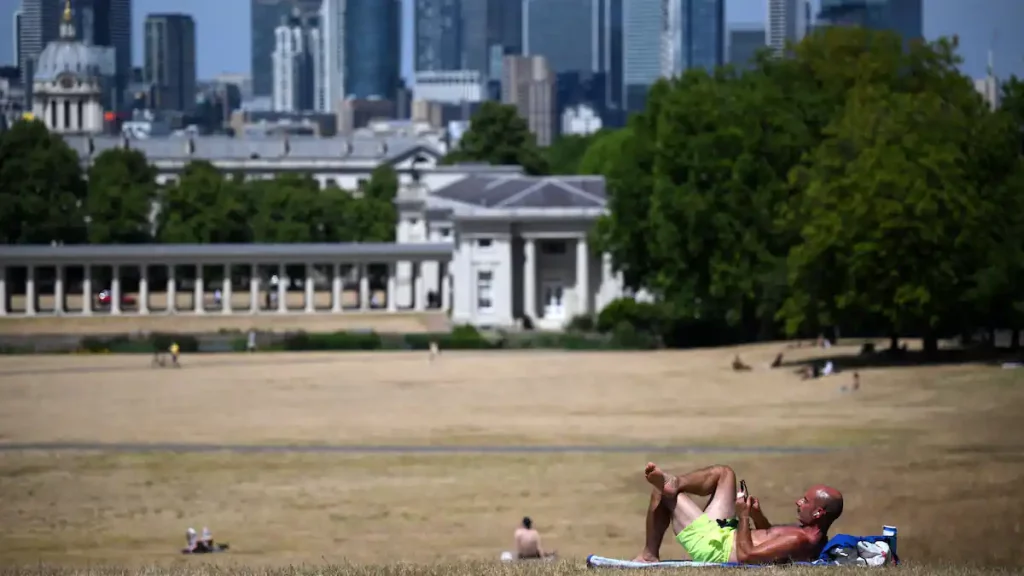A heat wave in Western Europe continues to bring devastating bushfires on Sunday and is expected to continue into the beginning of the week, when it could break many records in France and Great Britain.
• Read also: Europe is still engulfed in bushfires and heatwave
This heat wave is the second in barely a month in Europe. The proliferation of these phenomena is a direct result of global warming according to scientists, with greenhouse gas emissions increasing in intensity, duration and frequency.
Europe
In France, Greece, Portugal and Spain, fires have burned thousands of hectares, forcing thousands of residents and tourists to flee their homes, and last week killed many members of the emergency and firefighting services.
In southwest France, the mobilization of firefighters has not weakened, particularly in the Gironde where nearly 11,000 hectares of forest have been erupted by smoke since Tuesday, in the context of a generalized heat wave. Météo-France put 15 districts in the west of the country on a red alert for a “heat wave,” a sign of the peak of the sweltering heat.
Monday may be one of the hottest events ever recorded in France. The Met Office warns that “the heat is increasing and the heat wave is spreading across the country,” which expects to break many temperature records, especially in the west and southwest.
Météo France recommends that residents of the regions concerned exercise “absolute vigilance” in the face of “dangerous phenomena of exceptional severity”.
“In certain areas of the southwest, there will be an apocalypse of heat” that can reach 44 degrees in some places on Monday, followed by a “hot night,” according to Météo France.
The fire regained its intensity Sunday evening in the Gironde, especially in the Arcachon tourist basin, on the edge of the Atlantic Ocean.
In Teste-de-Buch, “The situation is deteriorating. The fire reached the sea and headed south, according to a tweet from the province calling for “extreme caution.”
Internet users posted on social networks photos and videos taken from the sea of this huge fire “30 meters high” devouring the shore of the lake, south of the dunes du Pilate.
In total, more than 16,200 residents and vacationers have had to urgently pack their bags since Tuesday.
In Lyon, the church next to the Grand Hôtel-Dieu offered a haven for tourists: “We went in to admire the place but we could no longer leave, it was too hot outside. We say a prayer in front of the oven!”, laughs Jean-Marc, 51, who came from Alsace (northeast) with his family.
In Spain, about 20 fires are still raging and still out of control in different parts of the country, from the south to the far northwest in Galicia, where the fires have so far destroyed about 4,400 hectares of vegetation this week, according to authorities.
Andalusian President Juan Manuel Moreno said a fire that broke out in the Mijas Mountains near the port city of Malaga on Friday was under control Sunday evening in the far south.
The fire destroyed nearly 2,000 hectares, according to local authorities, and caused the evacuation of more than 3,000 residents, but 2,000 have since been able to return to their homes and more are expected to follow, according to Moreno.
On Sunday, the thermometer reached 39 degrees in Madrid, 39.7 degrees in Seville (south), and a maximum of 43.4 degrees in Don Benito near Badajoz (east).
A 50-year-old man died, Sunday, of heatstroke while walking on the street in Torregon de Ardoz, near Madrid, according to emergency services. When help arrived, the man was in “cardiorespiratory arrest” and had a body temperature of 40 degrees Celsius. A 60-year-old road worker had died the day before in Madrid after also suffering heat stroke.
Portugal was experiencing a lull: On Sunday, for the first time since July 8, temperatures there did not exceed 40 degrees, according to the National Weather Service (IPMA), after hitting a historic record high for July of 47 on Thursday. °.
Calm is also on the fire front: one large focal point, near Chaves in the far north of the country, was considered active and “practically under control” over 90% of its surroundings according to the Portuguese Civil Protection.
However, almost all of the Portuguese territory posed an “extreme”, “very high” or “high” fire risk on Sunday, particularly the central and northern regions.
According to the last known report from the Portuguese authorities, last week’s fires left two dead and about sixty injured. They have destroyed between 12,000 and 15,000 hectares of forests and trees since the onset of the heat wave.
In northern Europe, in the United Kingdom, the national weather agency issued the first-ever “red” alert for extreme heat, warning of a “risk to life”. The Met Office said temperatures in southern England could hit 40 degrees for the first time on Monday or Tuesday.
The British government was accused, on Sunday, of not taking the heat wave seriously, after resigned Prime Minister Boris Johnson missed a crisis meeting on the subject in Downing Street, and his deputy, Dominic Raab, appeared happy for the first time with more than 40 degrees in England.
In the Netherlands, the Dutch Institute for Public Health and the Environment (RIVM) on Sunday announced a national heat plan and smog alert in effect from Monday across the country, predicting temperatures will rise in the next few days, as high as 35 degrees. Monday in the south and up to 38 degrees in some places Tuesday.
Canada
Elsewhere in the world, extreme temperatures have also caused wildfires, notably in northern Morocco where one person died and nearly half of 4,660 hectares of land, and in western Canada.

“Total coffee aficionado. Travel buff. Music ninja. Bacon nerd. Beeraholic.”







More Stories
Pennsylvania Primary: Good performance from… Nikki Haley!
US pushes TikTok towards exit
$1,800 for a “ministerial meeting” with foie gras in the office of André Laforest: PLQ accuses CAQ of mismanagement of public funds